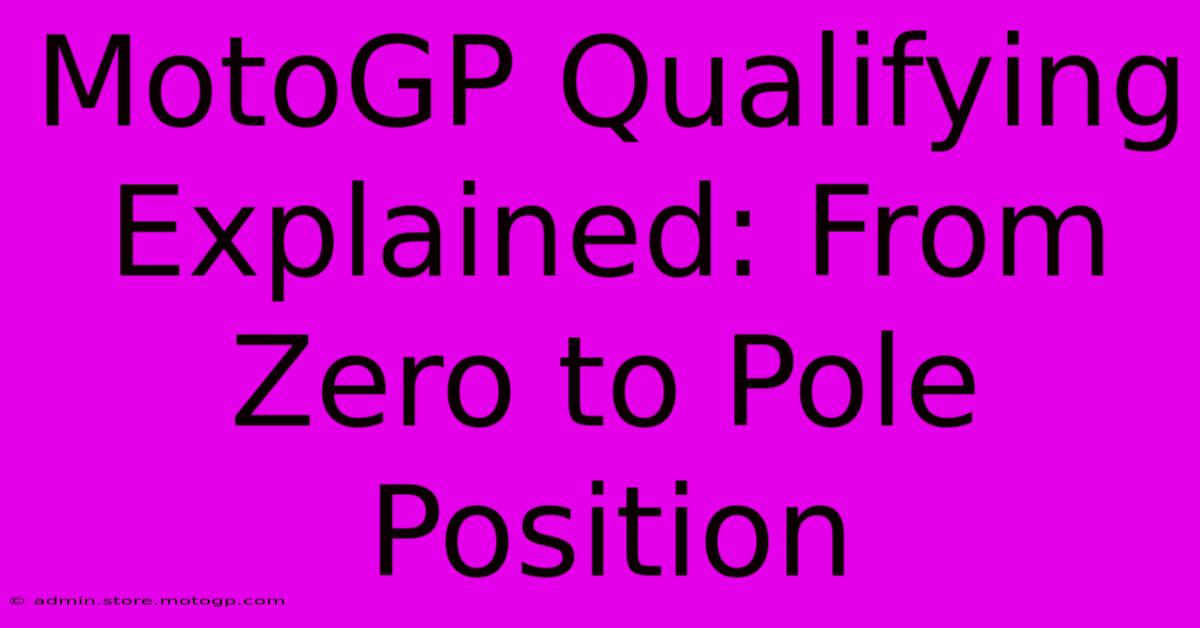MotoGP Qualifying Explained: From Zero To Pole Position

Table of Contents
MotoGP Qualifying Explained: From Zero to Pole Position
MotoGP racing is a spectacle of speed, skill, and strategy. But before the lights go out and the bikes thunder down the track, there's the crucial stage of qualifying – a nail-biting session that determines the starting grid for the race. Understanding how MotoGP qualifying works is key to appreciating the drama and the intricate calculations that go into achieving that coveted pole position. This guide breaks down the process from start to finish, explaining the intricacies and the importance of every stage.
The Qualifying Format: A Breakdown
MotoGP qualifying has evolved over the years, and the current format is designed to maximize excitement and competition. It's a multi-stage process, culminating in a final shootout for the top positions.
Q1 (Qualifying 1):
- Who's in? The ten slowest riders from the combined Free Practice (FP) sessions (FP1, FP2, FP3) start here. This initial session sets the stage for the main event. These riders are fighting for their spots in Q2.
- The Goal: The two fastest riders from Q1 automatically progress to Q2. The remaining eight riders will start from positions 13-20 on the grid, their race positions significantly impacted by their Q1 performance. The pressure is immense in this initial qualifying session.
- Time Limit: A short, intense session, typically 15 minutes. Every second counts!
Q2 (Qualifying 2):
- Who's in? The top 10 riders from the combined Free Practice sessions automatically qualify for Q2. They are joined by the two fastest riders who advanced from Q1. This session determines the front of the grid.
- The Goal: The fastest rider in Q2 secures pole position, while the rest of the top 12 fill the first four rows of the starting grid. This is where the real fight for grid supremacy happens.
- Time Limit: Similar to Q1, Q2 usually runs for 15 minutes. Every tenth of a second matters here. The battle is fierce, with riders constantly pushing their limits to improve lap times.
Strategies and Tactics: More Than Just Speed
MotoGP qualifying isn't simply about who's fastest on a single lap. Several factors contribute to a rider's success:
Tire Management:
Choosing the right tires and managing their wear throughout qualifying is crucial. Riders must balance pushing for a fast lap with preserving tire life for the race. A perfectly executed qualifying lap often hinges on making smart choices around tire usage.
Track Conditions:
Weather and track temperature play a significant role. Changes in conditions can drastically impact lap times, forcing riders to adapt their strategies on the fly. Being able to read the track and anticipate changes is a vital skill for a successful qualifier.
Slipstream (Drafting):
Riders often use each other for slipstreaming, gaining a speed advantage by riding closely behind another bike. This is a calculated risk, requiring precise timing and positioning to pull it off effectively. Mastering the art of slipstreaming can be the difference between a front row start and a place further back.
Bike Setup:
The bike's setup plays a critical part. A finely tuned machine is essential for optimal performance, allowing the rider to extract maximum speed and stability on each lap. Finding the right balance between setup and rider skill is a continuous challenge for teams.
The Importance of Qualifying: Setting the Stage for Race Day
A strong qualifying performance significantly influences a rider's chances of success in the race. Starting from pole position provides a considerable advantage, offering a better racing line and allowing riders to control the early stages of the race.
Starting further down the grid often means fighting through traffic, making overtaking more challenging and potentially impacting the final results. Qualifying sets the scene for the Grand Prix, making it a pivotal moment in the weekend's events. Every rider aims for the best possible grid position to maximize their chances of victory on race day.
Conclusion: From Q1 to Pole Position
MotoGP qualifying is a high-stakes battle of speed, strategy, and skill. It's a captivating spectacle that showcases the riders' talent and the teams' meticulous preparation. Understanding the format, the strategies involved, and the importance of each session allows fans to fully appreciate the drama and excitement of this crucial phase of a MotoGP weekend. The fight for pole position is a compelling microcosm of the entire racing season.

Thank you for visiting our website wich cover about MotoGP Qualifying Explained: From Zero To Pole Position. We hope the information provided has been useful to you. Feel free to contact us if you have any questions or need further assistance. See you next time and dont miss to bookmark.
Featured Posts
-
Lub Si Cota And Self Care Prioritizing Your Wellbeing
Feb 19, 2025
-
Moto Gp Sprint What The Riders Think
Feb 19, 2025
-
F1 Austin Music Get Ready For An Unforgettable Weekend
Feb 19, 2025
-
The Downforce Dilemma Moto Gp Aero Debates
Feb 19, 2025
-
Moto Gp Pictures For Every Fan
Feb 19, 2025
